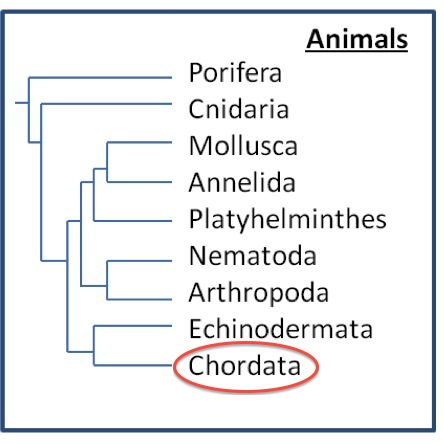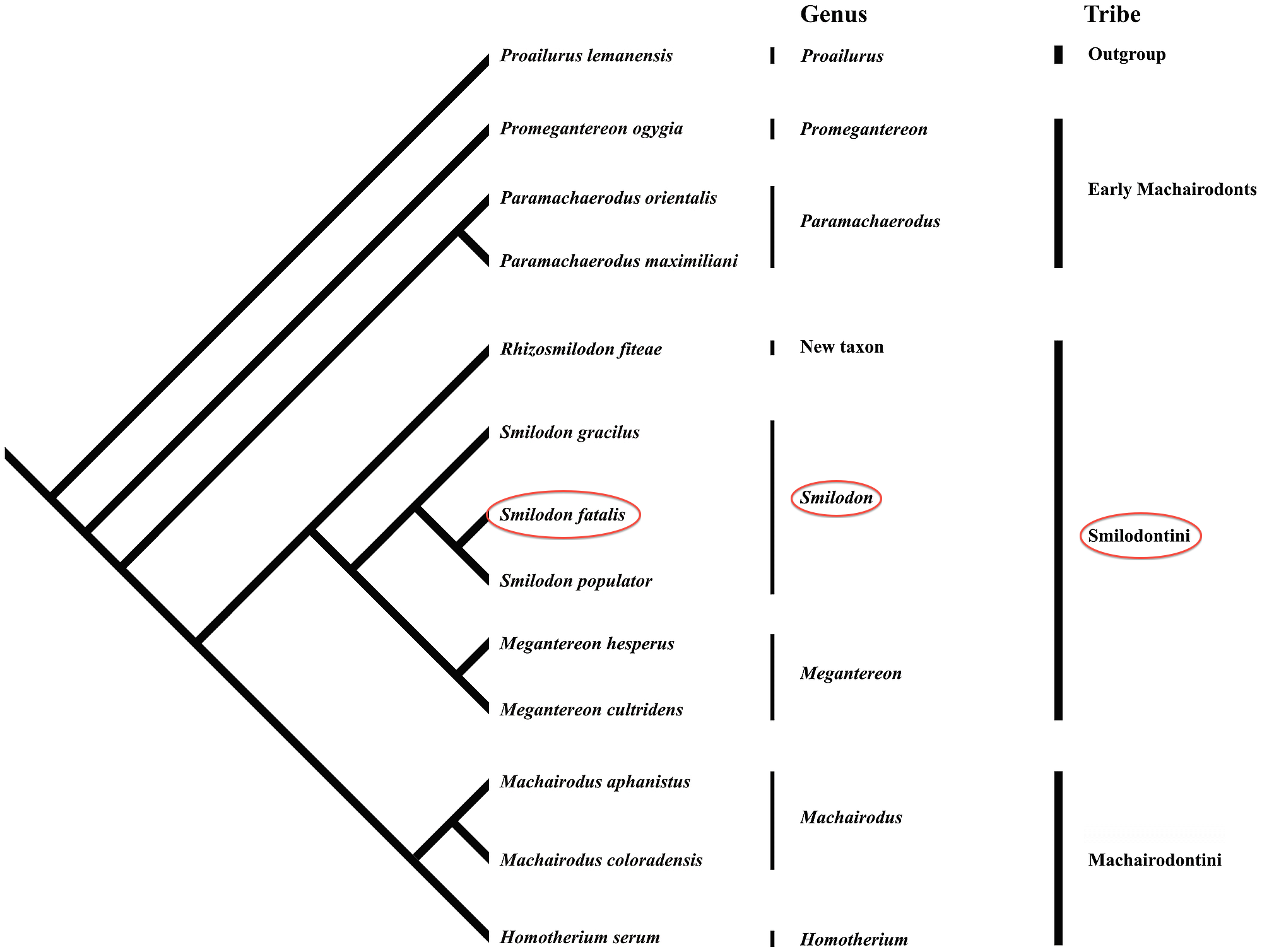Classification
Domain: Eukarya
The saber-tooth tiger belongs to the Domain Eukarya.
The main characteristic of this domain is that all organisms are
eukaryotic, where "eu" means true and "karyo" means nut or in
this case nucleus (Borror 1960). Along with the nucleus,
they also have membrane bound organelles such as mitochondria.
The domain Eukarya is highly diverse since it contains various
clades and numerous
kingdoms including
Plantae, Fungi, and Animalia. The saber-tooth tiger
belongs to the Kingdom Animalia.
Interested in learning about more organisms in the Domain Eukarya? Check out the Rockhopper Penguin, also known as Eudyptes chrysocome or the Golden Poppy, also known as Eschscholzia californica.
Kingdom: Animalia
The saber-tooth tiger belongs to the Kingdom Animalia.
Animalia stems from the Latin animale, derived from
animalis which means living soul (Borror 1960). The main characteristic
of this kingdom is the way by which they acquire nutrients.
Members of this kingdom are multicellular, heterotrophic organisms
composed of eukaryotic cells. The cells of these organisms are
organized into differentiated tissues, yet they lack cell walls.
Furthermore, they are motile at some stage in their lives.

Figure 2. Smilodon fatalis belongs to the Eukarya domain,
characterized by having a true nucleus. S. fatalis also
belongs to the Opisthokonta clade, which includes a broad group of
eukaryotes such as animal and fungi.
Interested in learning more about organisms in the Kingdom Animalia? Check out the Pacific Tree Frog, also known as Pseudacris regilla or the Hainan Gibbon, also known as Nomascus Hainanus.
Phylum: Chordata
The saber-tooth tiger belongs to the phylum Chordata.
Chordata stems from the Latin root chorda meaning chord,
referring to the characteristic of having a notochord at some point
during their development. Members of this phylum are also
characterized by deuterstome development. Deuterstomes stems
from the Greek root deutero meaning second and stoma
meaning mouth (Borror 1960). In the deuterstomes,
organisms develop an anus first followed by a mouth forming in
secondary development. Deuterstomes also have bilaterally
symmetry and are tripoblasts. Bilateral symmetry refers to the
body divided into equivalent right and left halves in one plane. Tripoblastic refers to three
primary layers such as ectoderm, mesoderm and endoderm.

Figure 3. Smilodon fatalis belong to the Kingdom Animalia,
characterized by the way they acquire their nutrients. They also
belong to the Chordata phylum, referring to the characteristic of
having a notochord at some point during their development.
Interested in learning more about organisms in the Phylum Chordata? Check out the Helmeted Hornbill, also known as Rhinoplax vigil or the Columbian Black Tailed Deer, also known as Odocoileus hemiounus columbianus.
Class: Mammalia
The saber-tooth tiger belongs to the Class Mammalia.
Mammalia stems from the Latin root mammal, referring to
vertebrate animals who feed their young with milk produced by
mammary glands (Borror 1960). Members of this phylum are
characterized by extreme parental care. Furthermore, most mammal
species grow from internal development of embryos; however, a few in
this class, such as monotremes, lay
eggs. Mammals also have hair at some point in their lives.
Interested in learning more about organisms in the Mammalia Class? Check out the Star-Nosed Mole, also known as Condylura cristata or the Southern Right Whales, also known as Eubalaena australia.
Order: Carnivora
The saber-toothed tiger belongs to the Order Carnivora.
Carnivora stems from the Latin root carni meaning flesh and
vorar meaning to devour (Borror 1960). Mammals
classified under this phylum generally have specialized teeth with
strong jaws used to eat other vertebrates; thus, these species are
flesh-eating organisms.
Interested in learning about more organisms in the Carnivora Order? Check out the long-tailed weasel, also known as Mustela frenata or the Common Genet, also known as Genetta genetta.
Family: Felidae
The saber-tooth tiger belongs to the Family Felidae.
Felidae stems from the Latin root feli meaning cat and
-idae is the suffix that is added to the roots of generic names
to form the names of families of animals (Borror 1960).
Members of this order are in the biological family of cats and
called felids. Felids are generally secretive animals,
nocturnal, and agile climbers. Furthermore, they can be found
in almost any environment, with some species being native to
different areas.
Genus: Smilodon
The saber-tooth tiger belongs to the Genus Smilodon.
Smilodon stems from the Latin root smilo meaning a carving
knife and odon means tooth (Borror 1960). Members of
this phylum are muscular predators and have curved, elongated
canines. Smilodon had relatively short legs and a short tail.
There are three species generally recognized under the genus
Smilodon: Smilodon gracilis, Smilodon populator, and
Smilodon fatalis. S. gracilis was the smallest of the
species and was mainly found the eastern part of the united states.
S. populator was of lion size and found in the eastern part of
south America. S. facilis was an intermediate size and
found in North and South America (Turner 39).
Species: Smilodon fatalis
The saber-tooth tiger belongs to the Species
Smilodon fatalis. The Latin word fatalis means
deadly (Borror 1960); hence, S. fatalis is often referred to as "the
deadly Smilodon." S. fatalis generally weighed
between 353-617 pounds and had a body length of 68.9 inches, a
height of 39.37 inches, and a tail length of 13.8 inches (Feranec
2003).

Figure 4. Smilodon fatalis, Smilodon gracilis, and
Smilodon populator belong to the Genus Smilodon and the
Tribe Smilodontini.
To continue on the journey, visit
Habitat next.
To return to the Smilodon fatalis homepage , click
here.
